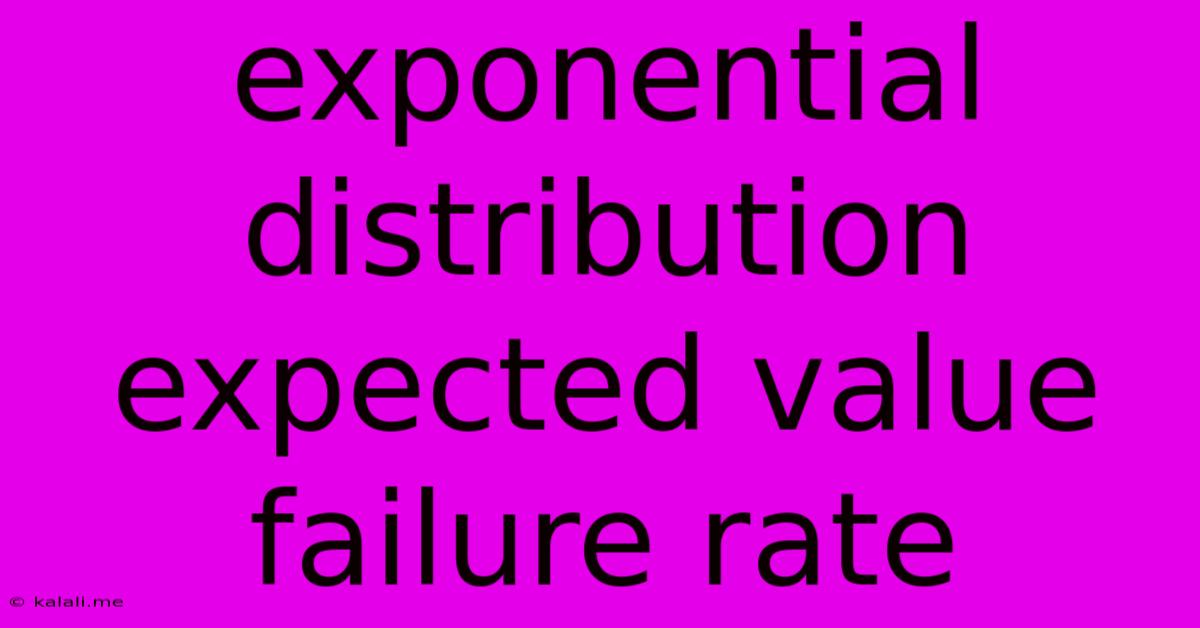Exponential Distribution Expected Value Failure Rate
Kalali
Jun 01, 2025 · 3 min read

Table of Contents
Understanding the Expected Value and Failure Rate in Exponential Distribution
The exponential distribution is a continuous probability distribution that's frequently used to model the time until an event occurs in various fields, including reliability engineering, queuing theory, and survival analysis. A key characteristic of this distribution is its constant failure rate, making it particularly useful for describing systems with a constant probability of failure over time. This article delves into the expected value (mean) and failure rate of the exponential distribution, explaining their relationship and practical applications.
What is the Exponential Distribution?
The exponential distribution is defined by a single parameter, λ (lambda), which represents the rate parameter. A higher λ indicates a higher probability of the event occurring within a given time period. The probability density function (PDF) of the exponential distribution is given by:
f(x) = λe^(-λx) for x ≥ 0
where:
- x represents the time until the event occurs
- λ > 0 is the rate parameter
The cumulative distribution function (CDF), which gives the probability that the event occurs before time x, is:
F(x) = 1 - e^(-λx) for x ≥ 0
Expected Value (Mean) of the Exponential Distribution
The expected value, or mean (E[X]), of an exponential distribution represents the average time until the event occurs. It's the average lifespan of a system with an exponentially distributed lifetime. The formula for the expected value is:
E[X] = 1/λ
This means that if the rate parameter λ is high, the average time until failure is short, and vice versa. A lower λ signifies a longer average lifespan. Understanding the expected value is crucial for predicting the average performance or lifespan of a system.
Failure Rate (Hazard Rate) of the Exponential Distribution
The failure rate, also known as the hazard rate, describes the instantaneous probability of failure at a given time, given that the system has survived up to that point. For the exponential distribution, the failure rate is constant and equal to the rate parameter λ.
h(x) = λ
This constant failure rate is a defining characteristic of the exponential distribution. It implies that the probability of failure in the next instant is independent of how long the system has already been operating. This assumption is valid in scenarios where the system doesn't age or degrade over time, or where such aging effects are negligible.
Relationship Between Expected Value and Failure Rate
The expected value (mean) and the failure rate are inversely proportional in the exponential distribution. As the failure rate (λ) increases, the expected value (1/λ) decreases. This intuitively makes sense: a higher failure rate leads to a shorter average lifespan.
Practical Applications
The exponential distribution and its associated expected value and failure rate are used extensively in various fields:
- Reliability Engineering: Modeling the time until equipment failure, predicting component lifespan, and assessing system reliability.
- Queuing Theory: Modeling the time between arrivals of customers in a queue or the service time in a service system.
- Survival Analysis: Analyzing the survival time of patients after a medical treatment or the lifespan of organisms.
- Finance: Modeling the time until a default event occurs in credit risk modeling.
Conclusion
The exponential distribution provides a valuable tool for analyzing and predicting events with constant failure rates. Understanding the relationship between its expected value and failure rate is crucial for interpreting the results and making informed decisions in a variety of applications. By grasping the concepts explained above, you can better leverage this distribution for your own analysis and modeling needs, whether in engineering, finance, or other fields.
Latest Posts
Latest Posts
-
Could Not Resolve Host Mirrorlist Centos Org Unknown Error
Jun 03, 2025
-
What You Up To Or Too
Jun 03, 2025
-
What Is This And Some Hole
Jun 03, 2025
-
How To Find Line Integral With Respect To Arc Lenth
Jun 03, 2025
-
Does A Magnet Work In Space
Jun 03, 2025
Related Post
Thank you for visiting our website which covers about Exponential Distribution Expected Value Failure Rate . We hope the information provided has been useful to you. Feel free to contact us if you have any questions or need further assistance. See you next time and don't miss to bookmark.